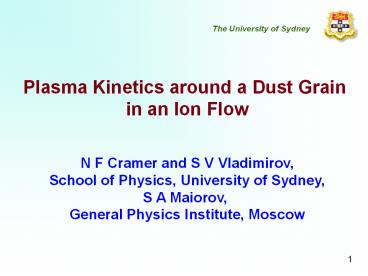Nonlinear Alfven waves in dusty astrophysical plasmas - PowerPoint PPT Presentation
1 / 15
Title:
Nonlinear Alfven waves in dusty astrophysical plasmas
Description:
Plasma Kinetics around a Dust Grain in an Ion Flow N F Cramer and S V Vladimirov, School of Physics, University of Sydney, S A Maiorov, General Physics Institute ... – PowerPoint PPT presentation
Number of Views:105
Avg rating:3.0/5.0
Title: Nonlinear Alfven waves in dusty astrophysical plasmas
1
The University of Sydney
Plasma Kinetics around a Dust Grain in an Ion
Flow N F Cramer and S V Vladimirov, School of
Physics, University of Sydney, S A Maiorov,
General Physics Institute, Moscow
1
2
The dust structures in a low-temperature weakly
ionized plasma have attracted considerable recent
attention associated with colloidal crystals, as
well as with other self-organized formations such
as dust clouds, drops", voids", etc. In a
typical laboratory discharge, dust particles are
negatively charged and usually levitate in the
sheath or pre-sheath region under the balance of
gravitational, electrostatic (due to the sheath
electric field) and plasma (such as the ion drag)
forces. The ion flow provides not only a direct
(dragging) influence, but is also responsible for
the generation of associated collective plasma
processes which can strongly affect the vertical
arrangement of dust grains.
2
3
Three-dimensional dust lattices
3
4
Dust charging
- Micrometer sized particles embedded in a plasma
acquire a charge if the main charging mechanism
is due to plasma currents then dust grains are
charged negatively
4
5
- The effect of the wake behind each grain in the
Mach cone (Vladimirov and Nambu, 1995 Vladimirov
and Ishihara 1996-1998)
-----------gt ion -----------gt
flow -----------gt to the -----------gt electrode
-----------gt
e l e c t r o d e
5
6
The kinetics of plasma particles around a
stationary dust grain in the presence of an ion
flow is studied using a 3-dimensional molecular
dynamics simulation method. The model is
self-consistent, involving the dynamics of plasma
electrons and ions as well as charging of the
dust grain. The effect of ion focusing is
investigated as a function of the ion flow
velocity. Distributions of electron and ion
number densities, and electrostatic plasma
potential are obtained.
6
7
The method includes consideration of the time
evolution of the system consisting of Ni
positively charged and Ne negatively charged
particles confined in a region 0ltxltLx, 0ltyltLy,
0ltzltLz. There is a macroscopic absorbing grain
(dust particle") of radius R with infinite mass
and an initial (negative) charge Q-Zde, where -e
is the electron charge. The dust grain is
placed at xx0, yy0, and zz0. The walls
bounding the simulation region are elastic for
electrons. For ions, they are elastic in the y
and z directions, i.e. at y(0,Ly) and z(0,Lz).
N
i
7
8
The ions are introduced in the system at the
plane x0 as a uniform flow with the Mach number
MV0/cs and the temperature Ti, where cs is the
ion-acoustic sound speed. At xLx the ions are
removed from the system. The paths of the ions
and electrons are determined through numerical
integration of the equations of motion, with all
particles interacting via the Coulomb force.
For the characteristic lengths we have
Lx/4LyLz10hx, with the characteristic grid
step hx4hy4hz1.077mm. Other initial values
are summarized in Table 1.
8
9
For the given values, the characteristic lengths
in the plasma are electron Debye length
rDe5.256mm, ion Debye length rDi0.831mm, and
the Landau length for scattering of the ions on
the dust particle by the angle p/2 is rL0.6/M2mm.
9
10
The total simulation time of the computed
physical processes is 3.36 x 10-9 s which is
approximately half the oscillation period of
plasma ions oscillating with the ion plasma
frequency.
10
11
Fig 1 Contour plots of the ion density, for
three values of the speed of the ion flow (one is
subsonic with M20.6, and two supersonic, with
M21.2 and M22.4). A strong ion focus is formed
at the distance of a fraction of the electron
Debye length behind the dust grain.
11
12
Fig. 2 surface plot of the ion density.The
maximum value of the density at the ion focus is
almost independent of the flow velocity, whereas
the characteristic distance of the ion focus from
the dust grain increases with increasing flow
velocity.
12
13
This characteristic spacing corresponds to an ion
focus effect in the near zone of the dust grain,
which is a purely kinetic effect not associated
with the collective wake field formation. The
oscillating wake field which is formed in the
wave zone behind the grain cannot form for the
considered simulation time (half of the period of
the ion oscillations). Another kinetic effect
seen from Figs. 1 and 2 is the appearance of
precursors in front of the dust grain, which can
be attributed to those ions reflected backwards
within the radius (around the x axis) of order of
the Landau length.
13
14
Fig. 3 Surface plot of the plasma electrostatic
potential (in Volts). The parts where the
potential becomes positive, thus forming an
attractive region for negatively charged
particles, can be seen behind the grain. The
potential well behind the dust grain deepens, and
the characteristic distance of the potential
minimum increases with the increase of the flow
velocity.
14
15
Conclusions MD calculations show plasma kinetics
around a charged macroscopic body (dust grain) in
the presence of an ion flow involves a strong ion
focusing behind the grain. The most important
for the processes involved is the ion time-scale
the kinetics of the electrons follows a Boltzmann
distribution with good agreement. To save
computer time, future MD simulations can assume
that the ions and the dust are immersed in an
electron background which obeys a Boltzmann
distribution.
15































